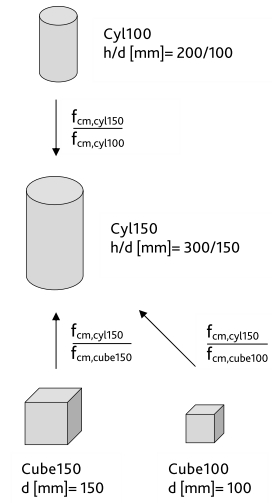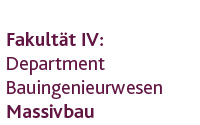.jpg)
Univ.-Prof. Dr.-Ing. Torsten Leutbecher
Raum: PB-A 111/2
 +49 271 740-2592
+49 271 740-2592
 leutbecher@bau.uni-siegen.de
leutbecher@bau.uni-siegen.de
Effect of specimen geometry on the compressive strength of ultra-high performance concrete
Research topic
Design and construction with ultra-high performance concrete (UHPC)
Funding and project duration
German Committee for Structural Concrete (Deutscher Ausschuss für Stahlbeton, DAfStb), Research Project V 497, sub-project B
Duration: February 2017 until January 2018
Person in charge
Philipp Riedel, M.Sc.
Project description
 The conformity check for ultra-high performance concrete (UHPC), which is subject of the current draft of the DAfStb Guideline "Ultra-High Performance Concrete", requires factors that allow a conversion between compressive strengths obtained for UHPC specimens with different shape and size. Up to now, there was a lack of reliable test results that could form the basis for defining generally applicable conversion factors. Therefore, the influence of the specimen geometry on the results of compressive strength tests on normal strength concrete (NSC), high strength concrete (HSC), and ultra-high performance concrete was investigated experimentally within the scope of a research project funded by the German Committee for Structural Concrete.
The conformity check for ultra-high performance concrete (UHPC), which is subject of the current draft of the DAfStb Guideline "Ultra-High Performance Concrete", requires factors that allow a conversion between compressive strengths obtained for UHPC specimens with different shape and size. Up to now, there was a lack of reliable test results that could form the basis for defining generally applicable conversion factors. Therefore, the influence of the specimen geometry on the results of compressive strength tests on normal strength concrete (NSC), high strength concrete (HSC), and ultra-high performance concrete was investigated experimentally within the scope of a research project funded by the German Committee for Structural Concrete.
The mean cylinder compressive strengths of the individual series ranged between approx. 30 MPa and 200 MPa. With maximum grain sizes of 0.5 mm, 3 mm, 5 mm, and 8 mm, the UHPC mixtures largely covered the scope of the forthcoming DAfStb Guideline.
The experimental work was carried out under the leadership of the Chair of Structural Concrete at the University of Siegen together with the University of Kassel and the RheinMain University of Applied Sciences. Compressive tests acc. to DIN EN 12390-3 were performed on cylinders with h/d [mm] = 300/150 (Cyl150) and cubes with d = 150 mm (Cube150), whose characteristic compressive strength will be used to classify UHPC. Besides, smaller cylinders with h/d [mm] = 200/100 (Cyl100) and smaller cubes with d = 100 mm (Cube100) were examined considering the limited capacities of the test machines used in practice.
Results of preliminary tests on appropriate specimen preparation led to the decision to grind also the loaded specimen faces of the cubes for HPC and UHPC in order to minimise the scattering of the test results. For this purpose, a specific grinding procedure consisting of four grinding passes and a specific evenness test
was developed to which all HSC and UHPC specimens were subjected before being tested in compression.
In addition, the UHPC test specimens were stored in water until testing.
The tests confirmed that appropriate accurateness in casting and preparing the specimens leads to a very small scattering of the test results even for UHPC without fibres. For 6 test results per series and specimen geometry, coefficients of variation of the compressive strength between 0.7 % and 3.0 % were obtained. The standard deviation exceeded 4 MPa in only four cases. In Series 7, the results for the cubes with d = 150 mm could not be included in the evaluation, since the standard deviation exceeded the self-defined margin of 6 MPa.
When evaluating the test results distinction is made between the influence of the specimen aspect ratio and the influence of the specimen size. The influence of the specimen aspect ratio decreases significantly with increasing concrete compressive strength. Ratios between cylinder and cube compressive strength of approx. 0.79 were obtained for concrete with fcm = 26.8 MPa, 0.84 for concrete with fcm = 78.5 MPa and - with increasing compressive strength - between 0.94 and 1.04 for UHPC. For specimens of different size, but with the same aspect ratio, the compressive strength differs only marginally. For the individual series, the specimens with d = 150 mm showed mean compressive strengths in the range of 0.95 to 1.02 times the strength of the specimens with d = 100 mm.
Based on these findings, the strength classes C130/140, C150/155, and C175/180 may be defined. The denominations adequately reflect the small difference between cylinder and cube strength observed in the tests. If test specimens with d = 100 mm are used for conformity checks, a reduction of the obtained compressive strength by 5 MPa is recommended to convert to the compressive strength of the corresponding larger reference specimen.
Publications
LEUTBECHER, T.; RIEDEL, P., 2020. Compressive strength classes and performance classes of ultra-high-performance concrete (Part 2) | Druckfestigkeits- und Leistungsklassen für ultrahochfesten Beton (Teil 2). Betonwerk und Fertigteil-Technik/Concrete Plant and Precast Technology. 86(10), 46-53. ISSN 0373-4331
LEUTBECHER, T.; RIEDEL, P., 2020. Compressive strength classes and performance classes of ultra-high-performance concrete (Part 1) | Druckfestigkeits- und Leistungsklassen für ultrahochfesten Beton (Teil 1). Betonwerk und Fertigteil-Technik/Concrete Plant and Precast Technology. 86(9), 46-54. ISSN 0373-4331
LEUTBECHER, T., 2020. Klassifizierung von ultrahochfestem Beton: Hintergründe und Prüfverfahren. In: Kongressunterlagen 64. BetonTage: Betonbau der Zukunft. Neu-Ulm, 18.-21. Februar 2020. Betonwerk und Fertigteil-Technik/Concrete Plant and Precast Technology. 86(2), 72. ISSN 0373-4331
RIEDEL, P.; LEUTBECHER, T.; PIOTROWSKI, S.; HEESE, C., 2019. Ratios of Compressive Strengths of Ultra-High-Performance Concrete Specimens of Different Shapes and Sizes. ACI Materials Journal. 116(6), 139-149. ISSN 0889-325X. doi:10.14359/51716983
RIEDEL, P.; LEUTBECHER, T.; PIOTROWSKI, S.; HEESE, C., 2018. Einfluss der Probekörpergeometrie auf die Ergebnisse von Druckfestigkeitsprüfungen an ultrahochfestem Beton. Beton- und Stahlbetonbau. 113(8), 598-607. ISSN 0005-9900. doi:10.1002/best.201800027
LEUTBECHER, T.; RIEDEL, P., 2018. Einfluss der Prüfkörpergeometrie auf die Ergebnisse von Druckfestigkeitsprüfungen an ultrahochfestem Beton (UHFB) [PowerPoint-Präsentation]. Dreikönigstreffen 2018 der MPA Wiesbaden. Hochschule RheinMain, Wiesbaden, 16. Januar 2018.
Download
RIEDEL, P.; LEUTBECHER, T., 2017. Effect of specimen size on the compressive strength of ultra-high performance concrete. In: TOUTLEMONDE, F.; RESPLENDINO, J., eds. UHPFRC 2017, Design and Building with UHPFRC: New large-scale implementations, recent technical advances, experience and standards. Proceedings of the AFGC-ACI-fib-RILEM International Conference on Ultra-High Performance Fibre-Reinforced Concrete. Montpellier, France, October 2-4, 2017. Paris: RILEM Publications, Volume I, pp. 251-260. RILEM Proceedings PRO 106. ISBN 978-2-35158-166-7
Download The original publication is available at the publisher's web site: https://www.rilem.net/publication/publication/490. The article is copyrighted by RILEM. Please contact RILEM for permission to reprint or use the material in any form.
